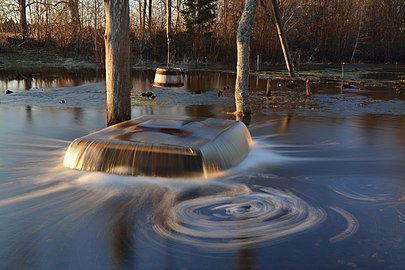Karst spring


A karst spring or karstic spring is a spring (exsurgence, outflow of groundwater) that is part of a karst hydrological system.[2]
Description
Because of their often conical or inverted bowl shape, karst springs are also known in German-speaking lands as a Topf ("pot") which is reflected in names such as
Karst springs often have a very high
Large karst springs are located in many parts of the world; the largest ones are believed to be in
Types
An estavelle or inversac is a ground orifice which, depending on weather conditions and season, can serve either as a sink or as a source of fresh water. It is a type of sinkhole.[4]
A Vauclusian spring is a spring that originates from a shaft or a cave system, with the water surging upwards under relatively high pressure. It is named after the Fontaine de Vaucluse in southern France.[4]
Submarine karst springs, also known as vruljas, occur worldwide, and are most numerous in shallow waters of the Mediterranean Sea.[4] They can be considered to be karst springs which have become submerged by rising sea levels.
For intermittent or rhythmic springs see below. They are part of another type of classification, which differentiates between perennial (with continuous flow), rhythmic, and temporary springs.[clarification needed]
Hydrological features
A main feature of karst springs is that water is rapidly transported by caverns, so that there is minimal filtering of the water and little separation of different sediments. Groundwater emerges at the spring within a few days from precipitation. Storms, snowmelt, and general seasonal changes in rainfall have a very noticeable and rapid effect on karst springs.[5]
Many karst springs dry up during the driest part of the year, and are thus known as
The properties of karst springs make them unsuitable for the supply of
Cultural references
The French Realist painter Gustave Courbet (1819–1877) painted a number of karst springs among many landscapes he depicted in the Jura region of eastern France.[8]
Gallery
-
Fontaine-de-Vaucluse, karst spring of the Sorgue, characterised by an upward movement of water from the depth of over 315 metres (1,033 ft)
-
A submarine karst spring (vrulja), observed through sea surface rippling near Omiš
-
Rhumequelle (Rhume Spring), source of the Rhume, in Herzberg am Harz-Rhumasprung (de) right next to Rhumspringe
-
Maramec Spring in the Ozarks, Missouri
-
The Mshentsy spring, Bologovsky district, Tver region, Russia
See also
References
- ^ Rogulj, Daniela (2016-10-04). "Drone footage of the Cetina like you have never seen before". Total Croatia News. Archived from the original on 2016-10-08.
- ISBN 0-14-051094-X.
- ISBN 9781118684993.
- ^ ISBN 978-3-540-61841-6.
- ^ "Geopark Schwäbische Alb". www.geopark-alb.de.
- ^ "Karst Features of Germany: Hungerbrunnen". showcaves.com.
- ISBN 978-3540618416.
- .
External links
- Karst springs in Germany (in German)
- The Hungerbrunnen in the Leinleiter valley (in German)






